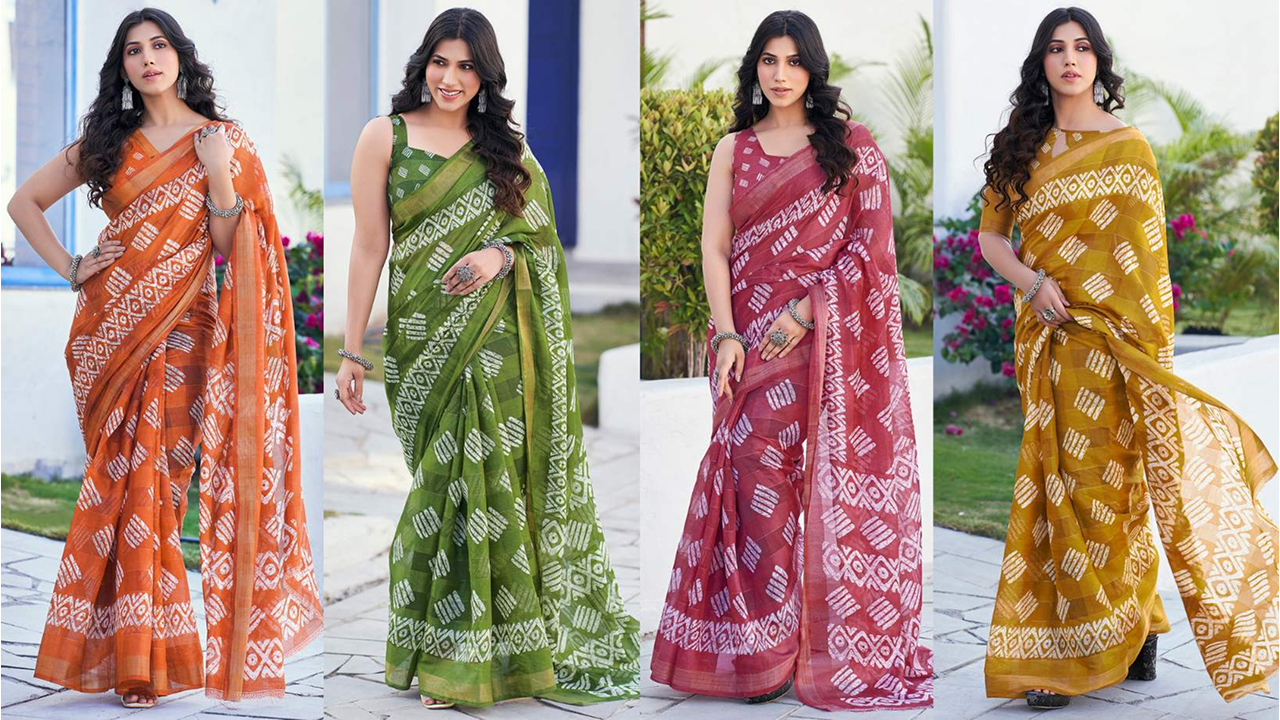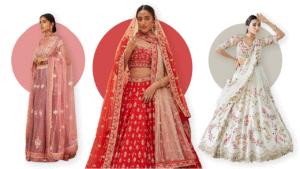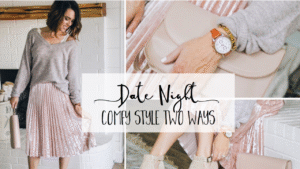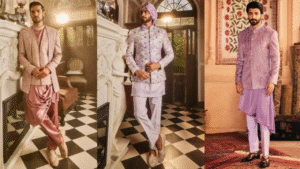Introduction
Saree is not just a piece of cloth. It is a story of culture, beauty, and tradition. In India, women have worn sarees for hundreds of years. Every state and community has its own way of wearing saree. A saree can be simple cotton, silk, designer, or even lightweight georgette. The magic of saree is in the draping style. The same saree can look completely different when you drape it in a new way. For festivals, women want to look special, unique, and stylish. That is why draping style matters a lot. Today, many modern draping styles are mixed with traditional ones. This makes saree fashion even more exciting. In this blog, we will explore different saree draping styles that will make your festive look more elegant. The language will be simple so everyone can understand. Whether you are young, middle-aged, or senior, there is a saree draping style for you.
Why Saree Draping Is Important
Saree draping is very important because it can completely change your look. When the saree is draped neatly, it makes you look taller, slimmer, and more graceful. The way you wear your saree shows your personality too. A traditional draping style gives you a classic and cultural look, while a modern draping style makes you look trendy and fashionable. During festivals, when you meet family and friends, the right saree style gives you confidence and makes you shine in the crowd. It also adds charm to your overall look. Each draping style highlights different parts of your body, like the waist, the pleats, or the pallu. This makes the saree look even more beautiful and special. A good drape also makes it easy to walk, sit, and move around during long festival hours. That is why choosing the right saree draping style is as important as choosing the saree itself.
Classic Draping Styles
1. Nivi Style
The Nivi style is the most common and popular way of draping a saree, and it first became famous in Andhra Pradesh. Today, women across India wear this style because it is simple, graceful, and very easy to handle. In this method, one end of the saree is tucked into the petticoat and then wrapped neatly around the waist. After that, pleats are made carefully in the middle and tucked inside to create a straight and balanced look. The pleats help the saree to fall beautifully and also make it easy to walk and sit. The last step is to take the pallu and place it gently over the left shoulder. The pallu can be left flowing at the back, or it can be pinned neatly for more comfort. The Nivi style is loved during festivals because it looks very elegant and neat, and it suits women of all ages and body types. It is also very easy to manage during long celebrations, where you may need to move, dance, or sit for long hours. Another reason why many women prefer this style is that it goes well with both heavy and simple jewelry. You can wear big necklaces, earrings, or bangles, and the saree will still look balanced and beautiful. This draping style also allows you to show the design of the pallu clearly, which makes the whole saree stand out. Because of its mix of comfort and elegance, the Nivi style has become the first choice for many women during festive occasions, weddings, and family gatherings.
2. Gujarati Style
The Gujarati style of saree draping is very famous during festivals like Navratri and also in traditional weddings. Unlike the regular Nivi style where the pallu goes to the back, in the Gujarati style the pallu comes to the front, which makes it look special and eye-catching. To drape it, you first start like the Nivi style by making neat pleats in the middle and tucking them in at the waist. After that, the pallu is taken from the back, brought across the chest, and then pinned neatly on the right shoulder. This way, the beautiful design and embroidery on the pallu can be seen clearly from the front. This style is perfect for festivals like Navratri and Diwali because it gives a rich, traditional, and grand look. It also allows women to dance, move, and celebrate freely while showing off the gorgeous patterns of their saree. The Gujarati style adds charm, elegance, and cultural beauty, which is why many women love to wear it during big celebrations.
3. Bengali Style
The Bengali saree style is known for its simple yet classy look, and it is one of the most recognized traditional drapes in India. This style is most often worn with red and white sarees, especially during the grand festival of Durga Puja, which makes it deeply connected with culture and tradition. To drape it, you do not start with pleats like other styles. Instead, the saree is first wrapped around the waist twice to give it a firm hold. Then, the pallu is thrown over the left shoulder in a loose and graceful way. After that, the pallu is brought back under the right arm and once again placed over the left shoulder, giving it a layered and elegant look. The beauty of the Bengali style is that it looks very ethnic and rich without being too complicated. It is the best choice for traditional puja celebrations because it allows women to carry heavy jewelry, big bindis, and sindoor with ease, completing the full festive appearance. This draping style not only represents Bengali culture but also adds grace and charm to any woman who wears it.
4. Maharashtrian Style
The Maharashtrian style of saree draping is very unique because it looks like a dhoti, which makes it different from most other saree styles. This style is usually seen during Ganesh Chaturthi and other traditional festivals in Maharashtra, where women wear it with pride and devotion. To drape it, a 9-yard saree is used instead of the regular 6-yard one. One part of the saree is brought between the legs and tucked in like a dhoti, which gives comfort and ease of movement. The rest of the saree is then arranged with normal pleats at the waist, and the pallu is placed over the shoulder in a graceful way. This style is very practical during long rituals and ceremonies because it allows free movement while still looking elegant. It also has a strong cultural and traditional value, as it has been worn by women in Maharashtra for generations. The Maharashtrian saree style looks bold, powerful, and unique, making it a perfect choice for festive occasions where tradition and style come together beautifully.
5. Tamilian Madisar Style
In Tamil Nadu, the Madisar saree is a very special draping style that is mostly worn during religious and spiritual occasions. It uses a 9-yard saree instead of the regular 6-yard one, which makes it look grand and different. The draping method is unique because the pleats go both in the front and the back, giving it a dhoti-like appearance that is comfortable for long hours of rituals. The pallu is then wrapped around the body in a traditional way, covering gracefully and adding a sense of devotion to the look. This style carries strong cultural meaning and is deeply connected with Tamil traditions, especially during festivals and temple ceremonies. Wearing a Madisar saree gives a traditional and devotional appearance that makes the wearer feel connected to heritage and spirituality. It is not only a style of clothing but also a symbol of respect for culture and religion, which is why it is still cherished during important festive occasions in Tamil Nadu.
Modern and Trendy Draping Styles
6. Lehenga Style Saree
The Lehenga style saree is a very popular modern draping method that makes a normal saree look like a lehenga. Instead of tucking the saree in the usual way, small pleats are made all around the waist so that the lower part looks just like a skirt. This gives the saree a flared and stylish shape, which is very easy to carry and walk in. The pallu is then taken over the shoulder and draped like a dupatta, adding more grace to the outfit. This style is especially loved during weddings, receptions, and festive parties because it gives a royal and grand look without needing too much effort. It is also the perfect choice for designer sarees, as the skirt-like bottom and flowing pallu help to show off the fabric and embroidery beautifully. The Lehenga style combines the beauty of a saree with the charm of a lehenga, making it a favorite for women who want to look elegant and fashionable at the same time.
7. Pant Style Saree
The Pant style saree is a modern draping method that is perfect for women who want both comfort and style. In this look, instead of wearing the traditional petticoat, you wear leggings or fitted pants, which makes the saree easier to handle. The saree is then tucked neatly around the pants, giving a sleek and stylish fit. The pallu can be taken over the shoulder in different creative ways, depending on how bold or fashionable you want the look to be. This style is especially popular among young women because it is comfortable and easy to carry for long hours. It is also a great choice for festivals like Navratri, where you need freedom to dance and move around during Garba or parties. The Pant style saree not only looks bold and trendy but also feels much lighter and easier compared to heavy traditional drapes. This mix of comfort and modern fashion makes it a favorite choice for festive occasions where you want to stand out and look stylish.
8. Dhoti Style Saree
The Dhoti style saree is quite similar to the pant style, but it has a more traditional touch as it looks like a dhoti. This draping method works best with a light fabric saree such as georgette, chiffon, or crepe because the material is easy to fold and manage. To drape it, the saree is wrapped in a way that one part goes between the legs, just like a dhoti, giving it a smart and unique appearance. The pallu is then left to fall casually over the shoulder, which adds a relaxed yet stylish charm to the look. This style is very popular among young girls and modern women who want something different from the regular saree drape. It is especially loved during festive functions and parties because it allows free movement while still looking fashionable. The Dhoti style saree is stylish, trendy, and a perfect mix of tradition and modernity, making it a bold choice for celebrations.
9. Butterfly Style
The Butterfly style saree is a glamorous and stylish draping method that gives a very modern look. In this style, the saree is first draped in the regular Nivi style, but the main difference comes in the way the pallu is arranged. The pallu is pleated into very thin folds and then spread carefully across the chest, which highlights the figure and gives a slimming effect. The rest of the pallu is left to fall lightly at the back, creating a graceful flow. This draping style is very popular at parties, receptions, and festive events because it looks fashionable and eye-catching. It is especially loved by women who want to show off their blouse designs or create a bold, elegant appearance. The Butterfly style not only makes you look slim and tall but also adds a touch of glamour, making it perfect for modern celebrations where you want to stand out.
10. Cape Style Saree
The Cape style saree is a modern and fashionable way of wearing a saree that adds a stylish twist to the traditional look. In this style, the saree is draped in the normal way with neat pleats and a pallu, but instead of leaving it plain, a cape or jacket is worn over the blouse. The cape can be long, short, sheer, or heavily designed depending on the occasion, and it instantly makes the saree look more glamorous. This style is very popular at evening festive parties, weddings, and receptions because it adds drama, elegance, and a designer touch without much effort. The Cape style saree is loved by modern women who want to mix tradition with fashion, making them look bold, trendy, and graceful at the same time.
Tips to Make Saree Draping Perfect
Choosing the right fabric is the first step to making your saree draping look perfect. Different fabrics give different effects. Cotton sarees are the best for comfort and daily wear, as they feel light and breathable. Silk sarees, on the other hand, are perfect for traditional functions and festivals because they look rich and elegant. If you want a modern and stylish appearance, fabrics like chiffon, georgette, or crepe are the best choices as they are flowy and easy to handle. So, always pick the fabric according to the occasion and the look you want. Using safety pins is another important tip that can save you from discomfort. Pins help keep the pleats and the pallu in place, especially during long hours of festivals and parties. With proper pinning, your saree stays neat and you do not have to adjust it again and again. The design of your blouse also plays a big role in your saree look. A classic blouse gives you a traditional and graceful appearance, while off-shoulder or halter neck blouses create a modern and bold style. Even a simple saree can look stylish if the blouse is designed well. Footwear should also be chosen carefully. Heels are always a great option because they make you look taller and give a better fall to the saree. Even a few inches of height can make your draping look more elegant and flattering. Jewelry must match the draping style to complete the look. If you are wearing a traditional style saree like Bengali or Maharashtrian, heavy jewelry with bangles, necklaces, and earrings will look perfect. But if you are wearing a modern style like Pant or Cape saree, then minimal and sleek jewelry will enhance the look better. Finally, never be afraid to experiment. Try new draping styles at home before wearing them at a festival. Practice will make you more confident and help you find the style that suits your body and personality the best. Experimenting also keeps your festive look fresh and exciting every time.
Saree Draping and Festivals A Connection
Sarees are not just outfits in festivals; they carry deep cultural meaning. Each festival has its own charm, and the draping style enhances the celebration mood. Here’s how different saree drapes beautifully connect with Indian festivals: Diwali: Go for Gujarati style with the pallu in the front or Lehenga style saree drape to look grand during family gatherings and card parties. The heavy borders and bright colors reflect the lights and sparkle of Diwali. Navratri: For Garba and Dandiya nights, Pant style or Dhoti style draping is perfect. These give freedom of movement, look trendy, and help you dance comfortably while still keeping the festive vibe. Durga Puja: The Bengali style saree with a red border on a white saree is the signature look of this festival. It symbolizes devotion, purity, and celebration of Goddess Durga. Perfect for sindoor khela and pandal hopping. Ganesh Chaturthi: The Maharashtrian Nauvari saree (draped like a dhoti) is widely worn during Ganpati festivities. It’s graceful yet comfortable, giving a traditional Marathi touch with green bangles and nose rings. Weddings: Sarees in Lehenga style or Butterfly style create a glamorous look for wedding functions. They make the bride or guest stand out while keeping the elegance of saree intact. Karva Chauth: On this day of love and fasting, women prefer Nivi style or Gujarati style sarees in bright reds and maroons with embroidery. The flowing pallu adds charm and grace to the occasion.
Conclusion
A saree is pure magic it can be traditional, modern, simple, or regal, all depending on how you drape it. Festivals are the perfect occasion to experiment with different draping styles, as they bring together culture, beauty, and celebration. From the classic Nivi and vibrant Gujarati, to chic Pant or glamorous Lehenga drapes, each style carries its own charm and personality. The right draping can transform your look, making you stand out while still embracing tradition. So, the next time you dress up for a festival, don’t just wear a saree style it in a way that reflects your mood, event, and personality. That’s how you elevate your festive look and step out feeling confident, beautiful, and truly special.



